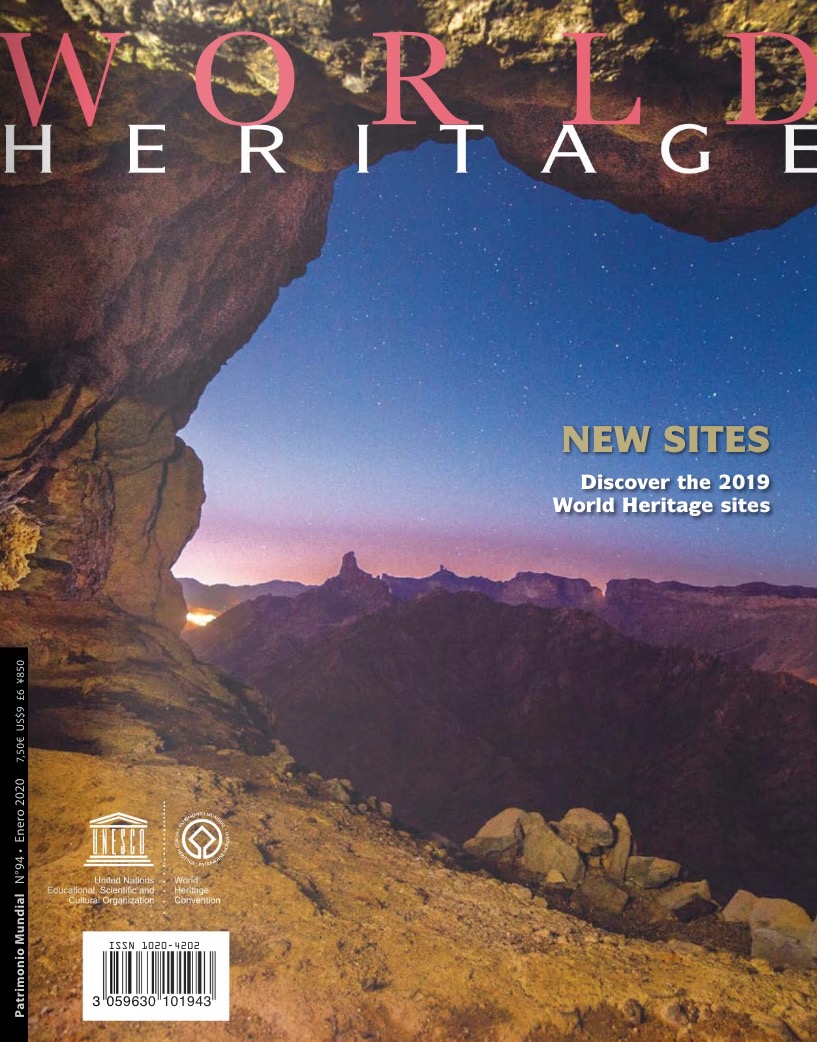![]() In attesa della 44a sessione del Comitato – poiché è stata rinviata a data da destinarsi a causa dell’emergenza Covid19 – vorremmo portarvi a scoprire i siti del patrimonio mondiale iscritti nel 2019: Per questo v invitiamo a leggere la rivista “World Heritage n ° 94″, pubblicata dall’UNESCO nel gennaio 2020 e disponibile in traduzione inglese, francese e spagnola.
In attesa della 44a sessione del Comitato – poiché è stata rinviata a data da destinarsi a causa dell’emergenza Covid19 – vorremmo portarvi a scoprire i siti del patrimonio mondiale iscritti nel 2019: Per questo v invitiamo a leggere la rivista “World Heritage n ° 94″, pubblicata dall’UNESCO nel gennaio 2020 e disponibile in traduzione inglese, francese e spagnola.
La Convenzione del patrimonio mondiale del 1972 è davvero unica. È l’unico strumento legale concepito per proteggere sia il patrimonio culturale sia quello naturale, basato sul principio di Outstanding Universal Value (OUV) – il valore di un sito che è insostituibile e deve essere protetto per il futuro.
Ogni anno, durante la sua sessione annuale, il Comitato del Patrimonio Mondiale aggiunge nuovi siti alla Lista del Patrimonio Mondiale dell’UNESCO. In questo numero, presentiamo i 29 siti aggiunti all’Elenco durante la 43a sessione del Comitato svoltasi dal 30 giugno al 10 luglio 2019 a Baku, Azerbaigian.
L’obiettivo chiave della Convenzione del patrimonio mondiale è la conservazione dei luoghi culturali e naturali in tutto il mondo di eccezionale valore universale. Non possiamo proteggere questi siti, nel nostro paese o altrove, se non ne siamo a conoscenza. Questo numero ti dà una breve occhiata a ciascuno di questi luoghi straordinari.
Ci sono sempre più disastri e conflitti in tutto il mondo, che minacciano questi luoghi preziosi. Gli effetti del cambiamento climatico stanno contribuendo a molti di questi fattori. All’UNESCO, ci impegniamo a riunire le competenze per guidare le azioni che aiuteranno con la conservazione del patrimonio. Non è sufficiente identificare il patrimonio e includerlo in un elenco. Supportiamo le autorità nazionali, le autorità locali e i gestori dei siti nel loro lavoro quotidiano di gestione e monitoraggio dello stato di conservazione di questi siti.
Dobbiamo agire in modo efficace per garantire che il nostro patrimonio possa resistere alle minacce o recuperare dai danni causati sia da cause naturali che umane. È più importante che mai sviluppare e accrescere la consapevolezza tra tutte le parti interessate di ciò che è veramente prezioso tra i nostri tesori creati dall’uomo e naturali, il nostro diverso patrimonio culturale e l’ambiente, in modo da poterlo conservare per le generazioni future.
![]()
Waiting for Committee’s 44rd session to come – as long as it has been delayed due to Covid Emergency – we’d like to bring you to discover the 2019 World Heritage Sites inviting you to read the Magazine “World Heritage n°94”, published by UNESCO in January 2020 and available in English, French and Spanish translation.
The 1972 World Heritage Convention is truly unique. It is the only legal instrument conceived to protect both cultural and natural heritage, based on the principle of Outstanding Universal Value (OUV) – the value of a site that is irreplaceable and must be protected for the future.
Each year, during its annual session, the World Heritage Committee adds new sites to the UNESCO World Heritage List. In this issue, we present the 29 sites added to the List during the Committee’s 43rd session held from 30 June to 10 July 2019 in Baku, Azerbaijan.
The key goal of the World Heritage Convention is the conservation of cultural and natural places around the world of Outstanding Universal Value. We cannot protect these sites, whether in our own country, or elsewhere, if we are not aware of them. This issue gives you a brief look at each of these extraordinary places.
There are more and more disasters and conflicts around the globe, which threaten these precious places. The effects of climate change are contributing to many of these factors. At UNESCO, we are dedicated to bringing together the expertise to guide actions that will help with heritage conservation. It is not enough to identify heritage and include it on a List. We support national authorities, local authorities and site managers in their daily work of managing and monitoring the state of conservation of these sites.
We must take effective action to ensure our heritage can withstand threats or recover from damage from both natural and human causes. It is more important than ever that we develop and enhance awareness among all stakeholders of what is truly valuable among our human-made and natural treasures, our diverse cultural heritage and environment, so that we can preserve it for future generations to enjoy.

